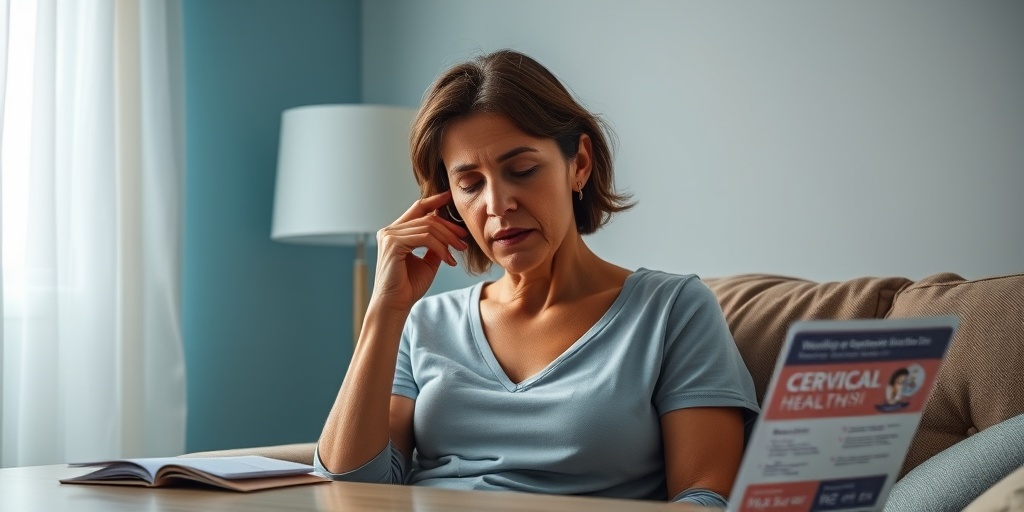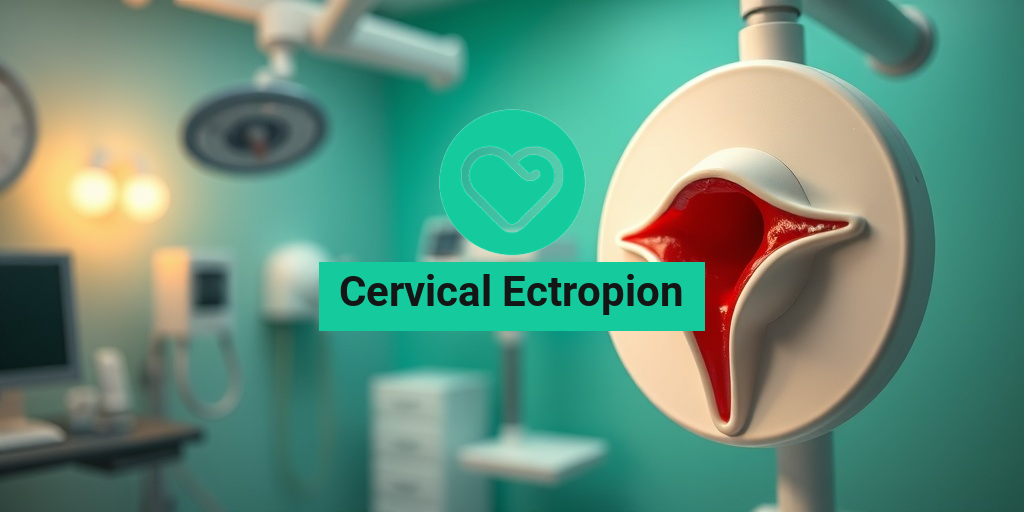What Is Cervical Ectropion?
Cervical ectropion, often referred to as cervical erosion, is a condition where the cells from the inside of the cervical canal (the endocervical cells) extend outward onto the surface of the cervix. This area is typically covered by squamous cells, which are flat and protective. When the endocervical cells protrude, it can lead to various symptoms and concerns for many women.
This condition is quite common and is often seen in women of reproductive age. It can occur due to hormonal changes, particularly during puberty, pregnancy, or when using hormonal contraceptives. While cervical ectropion is generally benign and not considered a serious health issue, it can sometimes cause discomfort and may raise concerns about other conditions, such as cervical cancer.
Causes of Cervical Ectropion
Understanding the causes of cervical ectropion can help demystify the condition. Here are some common factors:
- Hormonal Changes: Fluctuations in hormones, especially estrogen, can lead to the development of cervical ectropion.
- Pregnancy: The hormonal changes during pregnancy can cause the cervical cells to change, leading to ectropion.
- Use of Hormonal Contraceptives: Birth control methods that contain hormones can also contribute to this condition.
- Infections: Certain infections, particularly sexually transmitted infections (STIs), can irritate the cervix and lead to ectropion.
Cervical Ectropion Symptoms
Many women with cervical ectropion may not experience any noticeable symptoms. However, for those who do, the symptoms can vary in intensity. Here are some common signs to watch for:
1. Abnormal Vaginal Discharge
Women with cervical ectropion may notice an increase in vaginal discharge. This discharge can be clear, watery, or even slightly bloody. It’s important to monitor any changes, as unusual discharge can sometimes indicate an infection.
2. Bleeding Between Periods
One of the more concerning symptoms is bleeding between menstrual periods. This can occur after sexual intercourse or during ovulation. If you experience this, it’s advisable to consult a healthcare professional to rule out any serious conditions.
3. Pain During Intercourse
Some women report discomfort or pain during sexual intercourse, which can be attributed to the sensitive nature of the ectropion. If this symptom persists, seeking medical advice is recommended.
4. Pelvic Pain
While not as common, some women may experience pelvic pain associated with cervical ectropion. This can be due to inflammation or irritation of the cervix.
5. Changes in Menstrual Cycle
In some cases, cervical ectropion can lead to changes in the menstrual cycle, including heavier or more frequent periods. If you notice significant changes, it’s essential to discuss them with your doctor.
When to Seek Medical Advice
If you experience any of the symptoms mentioned above, especially abnormal bleeding or pain, it’s crucial to consult a healthcare provider. They can perform a thorough examination, including a Pap smear or colposcopy, to ensure that cervical ectropion is the cause and to rule out any other potential issues, such as cervical cancer.
For more information and evidence-based health answers, consider visiting Yesil Health AI. They provide valuable resources to help you understand your health better.
In conclusion, while cervical ectropion is often a benign condition, being aware of its symptoms and causes can empower you to take charge of your reproductive health. If you have any concerns, don’t hesitate to reach out to a healthcare professional for guidance. Remember, your health is your wealth! 💖

Cervical Ectropion Causes
Cervical ectropion, often referred to as cervical erosion, occurs when the cells from the inside of the cervical canal (columnar cells) extend to the outer surface of the cervix. This condition can lead to various symptoms, including unusual discharge and bleeding. Understanding the causes of cervical ectropion is essential for effective management and treatment.
Hormonal Changes
One of the primary causes of cervical ectropion is hormonal fluctuations, particularly those related to estrogen. These changes often occur during:
- Menstruation: The menstrual cycle can cause the cervix to undergo changes, making it more susceptible to ectropion.
- Pregnancy: Increased estrogen levels during pregnancy can lead to the development of cervical ectropion.
- Birth Control: Hormonal contraceptives may also influence cervical cell changes, contributing to ectropion.
Infections and Inflammation
Infections, particularly sexually transmitted infections (STIs) like human papillomavirus (HPV), can irritate the cervix and lead to ectropion. Chronic inflammation from conditions such as cervicitis can also play a role. Symptoms may include:
- Unusual discharge: A change in discharge consistency or color.
- Bleeding: Spotting or bleeding after intercourse or between periods.
Trauma or Injury
Physical trauma to the cervix, such as that which may occur during childbirth or certain medical procedures (like a biopsy), can lead to cervical ectropion. This trauma can disrupt the normal cell arrangement and promote the growth of columnar cells on the cervix’s outer surface.
Genetic Predisposition
Some women may have a genetic predisposition to developing cervical ectropion. If you have a family history of cervical issues, it may be worth discussing with your healthcare provider.
Cervical Ectropion Risk Factors
While cervical ectropion can occur in any woman, certain risk factors may increase the likelihood of developing this condition. Understanding these factors can help in early detection and management.
Age
Cervical ectropion is more common in younger women, particularly those under 25. This is often due to the hormonal changes that occur during puberty and early reproductive years.
Sexual Activity
Women who are sexually active, especially those with multiple partners, may have a higher risk of developing cervical ectropion. This is largely due to the increased likelihood of STIs, which can irritate the cervix.
History of Cervical Procedures
Women who have undergone cervical procedures, such as a cone biopsy or LEEP (Loop Electrosurgical Excision Procedure), are at a greater risk for cervical ectropion. These procedures can alter the cervical tissue and lead to ectropion development.
Use of Hormonal Contraceptives
As mentioned earlier, hormonal contraceptives can influence cervical cell changes. Women using these methods may be at an increased risk for developing cervical ectropion due to the hormonal fluctuations they induce.
Chronic Infections
Women with a history of chronic infections, particularly STIs, are at a higher risk for cervical ectropion. Regular screenings and prompt treatment of infections can help mitigate this risk.
In conclusion, understanding the causes and risk factors associated with cervical ectropion is crucial for women’s health. If you experience symptoms such as unusual discharge or bleeding, it’s important to consult with a healthcare provider for proper evaluation and management. Remember, early detection can lead to better outcomes! 🌸

Cervical Ectropion Diagnosis
Cervical ectropion, often referred to as cervical erosion, is a condition where the cells from the inside of the cervical canal grow on the outside of the cervix. While it is generally benign, understanding how it is diagnosed is crucial for effective management. Here’s what you need to know about the diagnosis of cervical ectropion.
Understanding the Symptoms
Before a diagnosis can be made, it’s important to recognize the cervical ectropion symptoms. Many women may not experience any symptoms at all, but some common signs include:
- Abnormal vaginal discharge: This may be more watery or have a different color than usual.
- Bleeding: Light bleeding or spotting, especially after intercourse or during menstruation.
- Pelvic pain: Some women report discomfort or pain in the pelvic area.
Medical Examination
The diagnosis of cervical ectropion typically begins with a thorough medical history and a physical examination. Your healthcare provider may perform a pelvic exam to visually inspect the cervix. During this examination, they will look for:
- Red, inflamed areas: The ectropion may appear as a red, inflamed area on the cervix.
- Friable tissue: The tissue may bleed easily when touched.
Diagnostic Tests
If cervical ectropion is suspected, your doctor may recommend further tests to confirm the diagnosis and rule out other conditions. These tests may include:
- Pap smear: This test helps detect any abnormal cells on the cervix.
- Colposcopy: A more detailed examination of the cervix using a special magnifying instrument.
- Biopsy: In some cases, a small sample of cervical tissue may be taken for further analysis.
It’s essential to discuss any concerns you have with your healthcare provider, especially if you experience symptoms like bleeding during sex or unusual discharge. Early diagnosis can help manage the condition effectively.
Cervical Ectropion Treatment Options
Once diagnosed, understanding the cervical ectropion treatment options is vital for managing the condition. While many cases do not require treatment, there are several approaches available if symptoms are present or if the ectropion is causing complications.
Observation and Monitoring
In many instances, especially if there are no significant symptoms, your doctor may recommend a watchful waiting approach. Regular monitoring through follow-up appointments can help ensure that the condition does not worsen.
Medications
If symptoms such as bleeding or discharge are bothersome, your healthcare provider may prescribe medications. These can include:
- Hormonal treatments: Birth control pills or hormonal therapies may help regulate menstrual cycles and reduce symptoms.
- Antibiotics: If there is an underlying infection contributing to the symptoms, antibiotics may be prescribed.
Minimally Invasive Procedures
For cases where symptoms persist or worsen, several minimally invasive procedures can be considered:
- Cauterization: This procedure uses heat to destroy the abnormal tissue on the cervix.
- Laser therapy: A laser is used to remove the ectropion tissue effectively.
- Cryotherapy: This involves freezing the abnormal tissue to eliminate it.
Considerations During Pregnancy
For women who are pregnant, the management of cervical ectropion may differ. It’s crucial to consult with your healthcare provider about any symptoms you experience, such as cervical ectropion pregnancy bleeding. In many cases, the ectropion may resolve on its own after childbirth.
When to Seek Help
If you experience persistent symptoms or have concerns about cervical ectropion, it’s essential to seek medical advice. Conditions like cervical ectropion vs cancer can be a source of anxiety, but understanding your diagnosis and treatment options can provide peace of mind.
In conclusion, while cervical ectropion is often benign, being informed about its diagnosis and treatment options is crucial for maintaining reproductive health. Regular check-ups and open communication with your healthcare provider can help manage any concerns effectively. 🌸

Cervical Ectropion Home Remedies
Cervical ectropion, a condition where the cells from the inside of the cervical canal grow on the outside of the cervix, can lead to various symptoms such as unusual discharge, bleeding, and discomfort. While medical treatment is often necessary, many individuals seek home remedies to alleviate symptoms and promote healing. Here are some effective strategies you can consider:
1. Maintain Proper Hygiene
Keeping the genital area clean is crucial. Use mild, unscented soaps and warm water to wash the area daily. Avoid douching, as it can disrupt the natural balance of bacteria and lead to infections.
2. Herbal Remedies
Some herbs are known for their anti-inflammatory and soothing properties. Consider the following:
- Chamomile: Known for its calming effects, chamomile tea can help reduce inflammation.
- Calendula: This herb can be used in creams or ointments to soothe irritated skin.
- Ginger: Consuming ginger tea may help improve circulation and reduce inflammation.
3. Dietary Adjustments
A healthy diet can support your immune system and overall health. Incorporate foods rich in vitamins and minerals, such as:
- Fruits and Vegetables: Especially those high in vitamin C, like oranges and bell peppers.
- Whole Grains: Foods like brown rice and quinoa can provide essential nutrients.
- Healthy Fats: Avocados, nuts, and olive oil can help reduce inflammation.
4. Warm Compresses
Applying a warm compress to the lower abdomen can help relieve discomfort and promote blood flow. Make sure the compress is not too hot to avoid burns.
5. Stress Management
Stress can exacerbate symptoms. Engage in relaxation techniques such as:
- Meditation: Helps calm the mind and reduce stress levels.
- Yoga: Gentle yoga can improve flexibility and promote relaxation.
- Deep Breathing: Simple breathing exercises can help manage anxiety.
6. Avoid Irritants
Stay away from products that can irritate the vaginal area, such as scented tampons, pads, and soaps. Opt for unscented products to minimize irritation.
Cervical Ectropion Outlook and Management
The outlook for individuals with cervical ectropion is generally positive. Most cases are benign and do not lead to serious complications. However, understanding how to manage the condition effectively is essential for maintaining health and well-being.
Understanding the Condition
Cervical ectropion is often caused by hormonal changes, particularly during pregnancy or when using hormonal contraceptives. It can also be associated with conditions like HPV (human papillomavirus). Regular check-ups with your healthcare provider are crucial to monitor any changes.
Regular Monitoring
For those diagnosed with cervical ectropion, regular gynecological exams are vital. Your doctor may recommend:
- Pap Smears: To check for any abnormal cell changes.
- Colposcopy: A procedure to closely examine the cervix.
Treatment Options
If symptoms are severe or persistent, medical treatments may be necessary. Options include:
- Cauterization: A procedure that uses heat to remove the ectropion.
- Laser Therapy: This method can effectively treat the affected area.
Managing Symptoms
In addition to home remedies, managing symptoms is essential. If you experience bleeding during sex or unusual discharge, consult your healthcare provider. They can offer tailored advice and treatment options.
When to Seek Medical Attention
While cervical ectropion is usually harmless, certain symptoms warrant immediate medical attention:
- Heavy Bleeding: If you experience heavy bleeding that soaks through pads or tampons.
- Severe Pain: Unexplained or severe pelvic pain should be evaluated.
- Changes in Discharge: If you notice a significant change in the color or odor of your discharge.
In conclusion, while cervical ectropion can be concerning, understanding the condition and exploring both home remedies and medical management can help you maintain your health and well-being. Remember, always consult with a healthcare professional for personalized advice and treatment options. 🌼

Frequently Asked Questions about Cervical Ectropion
What is Cervical Ectropion?
Cervical ectropion is a condition where the cells from the inside of the cervical canal grow on the outside of the cervix. This can lead to various symptoms and may require medical attention.
What are the symptoms of Cervical Ectropion?
Common symptoms include:
- Abnormal vaginal discharge – This may be more watery or mucous-like.
- Bleeding – This can occur after sexual intercourse or between periods.
- Pelvic pain – Some individuals may experience discomfort.
Can Cervical Ectropion affect pregnancy?
While cervical ectropion itself is generally not harmful during pregnancy, it can cause some bleeding or discharge. It’s important to discuss any concerns with your healthcare provider.
How is Cervical Ectropion diagnosed?
Diagnosis typically involves a pelvic examination and may include a PAP smear or a colposcopy to assess the cervix more closely.
What causes Cervical Ectropion?
The exact cause of cervical ectropion is not fully understood, but it may be linked to hormonal changes, particularly during puberty, pregnancy, or the use of hormonal contraceptives.
Is Cervical Ectropion related to cancer?
No, cervical ectropion is not cancerous. However, it is important to monitor any changes and consult with a healthcare provider to rule out other conditions.
What should I do if I experience symptoms?
If you notice symptoms such as unusual bleeding or discharge, it is advisable to consult a healthcare professional for an evaluation and appropriate management.
Can Cervical Ectropion be treated?
Treatment may not be necessary if symptoms are mild. However, if symptoms are bothersome, options may include:
- Cauterization – A procedure to remove the ectropion.
- Medication – To manage symptoms.
Are there any lifestyle changes that can help?
Maintaining a healthy lifestyle, including a balanced diet and regular exercise, can support overall reproductive health. Avoiding irritants such as douches or harsh soaps may also help reduce symptoms.
Where can I find more information?
For more detailed information, consider visiting reputable health websites or consulting with a healthcare provider who specializes in women’s health.




